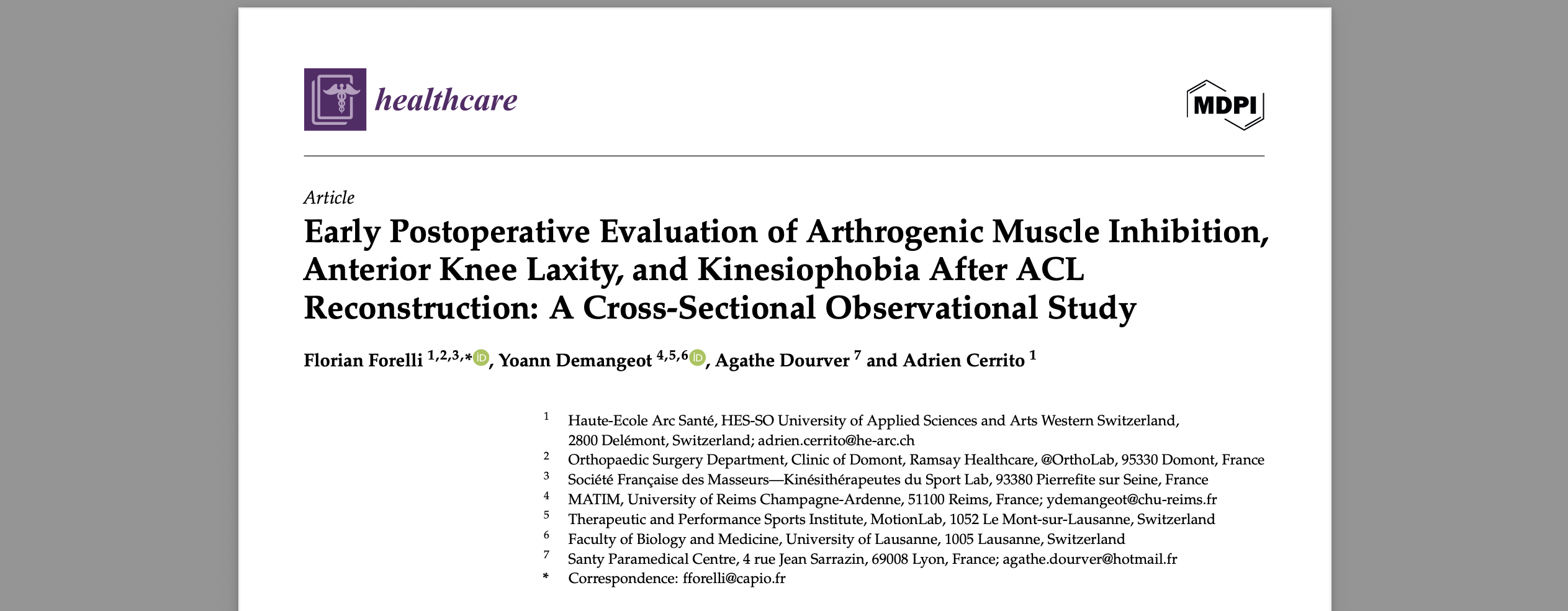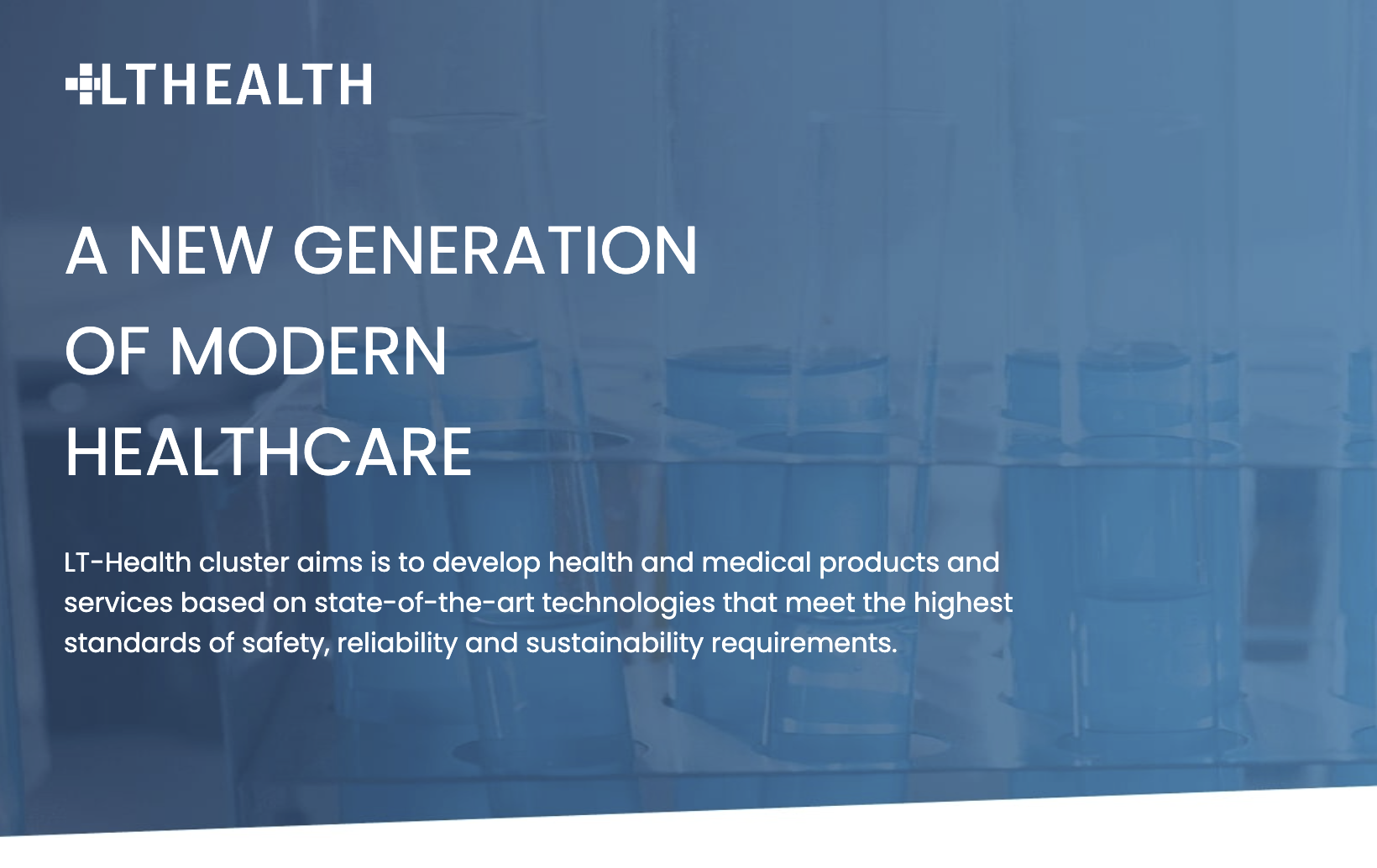Anterior cruciate ligament (ACL) injuries are a common and significant concern, affecting athletes and non-athletes alike. These injuries can lead to prolonged downtime from sports, decreased quality of life, and the potential for long-term knee issues such as osteoarthritis. Accurate and early diagnosis is critical for effective treatment planning, including decisions regarding surgery or conservative management. In this context, arthrometers have emerged as indispensable tools in the clinical assessment of knee laxity, offering objective measurements that can guide diagnostic and therapeutic choices.
The GNRB/Dyneelax and Telos Stress Device are among the most advanced arthrometers currently available, designed to quantify anterior knee laxity with precision. These devices have been subject to numerous studies aiming to validate their efficacy, reliability, and diagnostic accuracy in the context of ACL injuries. While both arthrometers have shown promise, there remains a need for a thorough comparative analysis to understand their relative strengths and limitations.
This article aims to provide a comprehensive comparison between the GNRB/Dyneelax and Telos Stress Device, focusing on their application in diagnosing ACL injuries. By examining a range of factors including accuracy, reproducibility, ease of use, and patient comfort, alongside insights from six pivotal studies, we endeavor to offer valuable guidance for clinicians in selecting the most appropriate device. Such an analysis is not only crucial for enhancing clinical outcomes but also for advancing our understanding of knee laxity assessment tools in the evolving landscape of sports medicine and orthopaedics.
I. Background
The anterior cruciate ligament (ACL) plays a pivotal role in maintaining knee stability and function. Injuries to the ACL can lead to significant instability, increasing the risk of further knee damage and compromising athletic performance. Over the years, the medical community has sought to improve the diagnosis and management of ACL injuries, with arthrometers becoming a cornerstone in the objective assessment of knee laxity.
Arthrometers measure the anterior-posterior movement of the tibia relative to the femur, providing quantifiable data on the integrity of the ACL. The evolution of these devices has been driven by the need for accurate, reproducible, and user-friendly tools that can support clinical assessments and guide treatment decisions. Among the array of devices developed, the GNRB/Dyneelax and Telos Stress Device have emerged as leaders in the field, thanks to their innovative designs and sophisticated measurement capabilities.
The GNRB and Dyneelax arthrometers mark a pivotal advancement in ACL injury diagnostics, moving beyond the variability of manual examinations to an automated, consistent application of pressure on the tibia. This automation minimizes operator error, ensuring reliable measurements of knee laxity crucial for determining treatment pathways. The GNRB component precisely applies anterior force, measuring anterior tibial translation (ATT), essential for assessing ACL integrity. This process’s accuracy is key in diagnosing the extent of injury and guiding treatment decisions. Furthermore, the Dyneelax extends the system’s capabilities by not only measuring ATT but also evaluating rotational stability through internal and external rotation assessments. This comprehensive approach offers deeper insights into knee mechanics, highlighting Dyneelax’s value in diagnosing subtle instabilities beyond translational movements. This dual assessment significantly benefits clinical settings by enhancing diagnostic accuracy and patient comfort. Both GNRB and Dyneelax become an indispensable tool for orthopedic clinicians, allowing for more tailored and effective treatment strategies for ACL injuries.
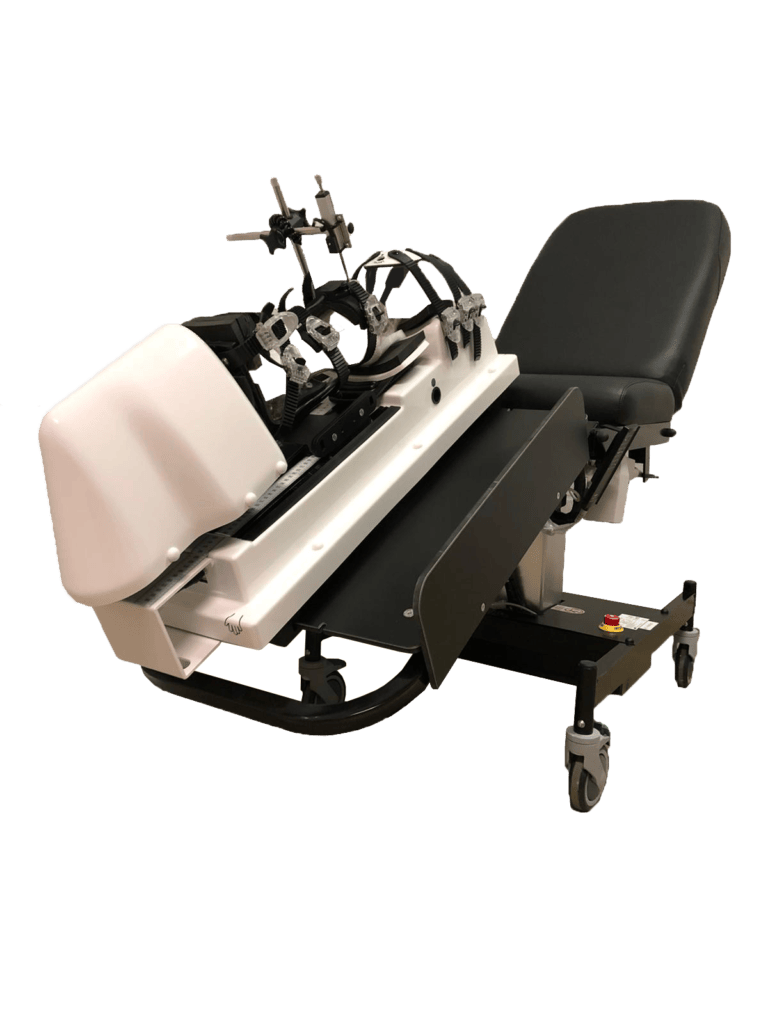
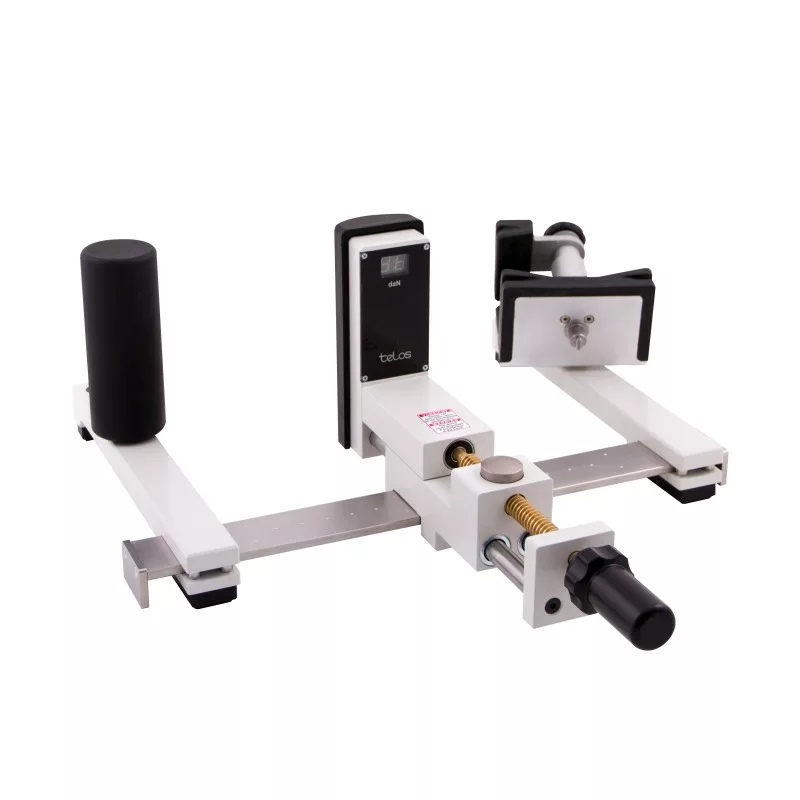
The Telos Stress Device takes a distinct approach to assessing knee laxity, leveraging stress radiographs to illuminate the structural integrity of the knee under pressure. This method is particularly esteemed for its capacity to visually document the tibia’s displacement when subjected to stress, providing a transparent and objective snapshot of the knee’s condition. Such visual confirmation is invaluable, offering clinicians a direct view of the knee’s biomechanical behavior that textual data alone cannot convey. By integrating radiographic imaging, the Telos device allows for a nuanced interpretation of knee stability, making it easier to pinpoint the precise nature and extent of injuries.
However, the incorporation of radiographs in knee laxity assessment introduces the consideration of radiation exposure. Mindful of this, the design of the Telos Stress Device is centered around optimizing the diagnostic benefits while ensuring patient safety. Strategies to minimize risk include targeted application of radiographs and adherence to the lowest effective dose principle, ensuring that the diagnostic advantages significantly outweigh the minimal radiation exposure. This careful balance between risk and reward underscores the Telos device’s role in modern orthopedic diagnostics, providing a high-value tool that enriches the clinician’s arsenal with detailed insights into the knee’s structural health, ultimately facilitating more informed and precise treatment decisions.
The necessity of comparing these arthrometers arises from their distinct mechanisms of action and the implications of their use in clinical practice. For instance, the ease of use and patient comfort associated with the GNRB and Dyneelax might be contrasted with the diagnostic depth provided by the Telos Stress Device’s radiographic approach. Understanding these differences is crucial for clinicians who rely on these tools for diagnosing ACL injuries, as the choice of device can affect the accuracy of diagnosis, patient experience, and ultimately, the success of treatment outcomes.
As the field of sports medicine and orthopedics continues to evolve, the comparative analysis of arthrometers like GNRB/Dyneelax and Telos becomes increasingly important. Such evaluations not only inform clinical practice but also guide future innovations in the design and application of diagnostic tools for ACL injuries, ensuring that patients receive the most effective and personalized care possible.
This background sets the foundation for an in-depth comparison of the GNRB/Dyneelax and Telos Stress Device, highlighting their significance in the ongoing effort to improve ACL injury diagnosis and management.
II. Comparative Analysis: GNRB/Dyneelax vs Telos Stress Device
The comparative analysis of the GNRB/Dyneelax and Telos Stress Device delves into their efficacy, reliability, and diagnostic precision in assessing ACL injuries. This section synthesizes findings from six pivotal studies, offering a comprehensive overview of each device’s performance under clinical scrutiny.
2.1 Methodology Overview
Both devices were evaluated across several parameters, including accuracy, reproducibility, ease of use, patient comfort, and diagnostic value. The studies employed various methodologies, including prospective analyses and comparative evaluations, to ascertain the devices’ capabilities in measuring anterior tibial translation and knee rotational stability.
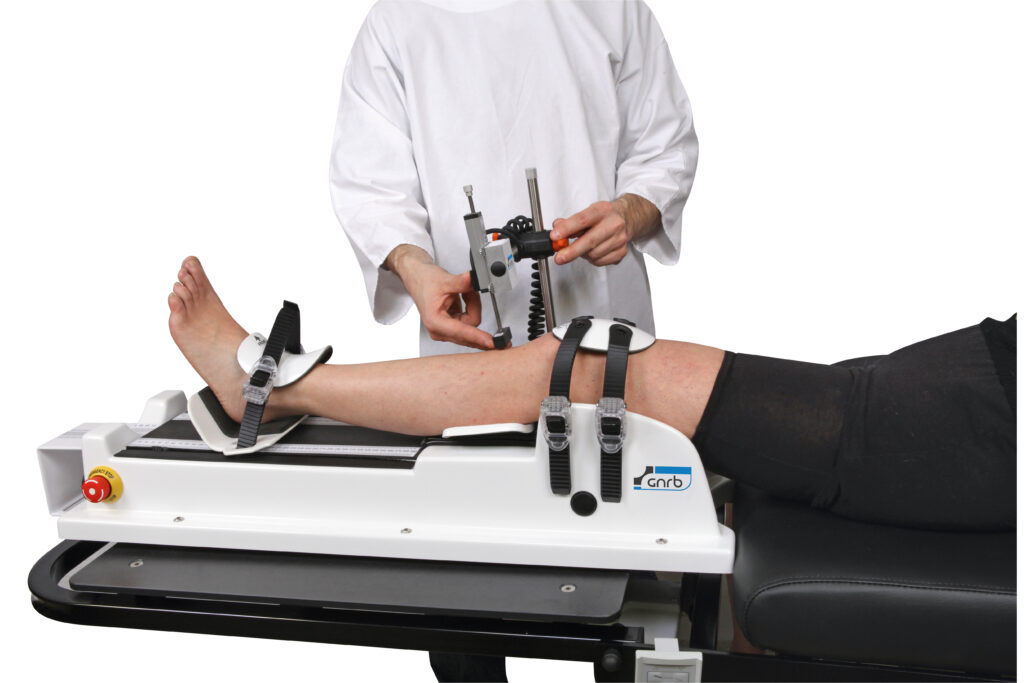
2.2 Study Summaries and Analysis
2012 Beldame Study (1): This study highlighted the GNRB’s superior reproducibility compared to Telos, noting a significant variance in passive stress radiographs for anterior knee laxity measurement. The GNRB’s automated pressure application was found to offer consistent results, underscoring its reliability in clinical settings.
2013 Lefevre Study (2): Focused on partial ACL tears, this research found the GNRB arthrometer had a diagnostic value higher than Telos, with a sensitivity of 84% and specificity of 81% for GNRB at 250 N force application. Such precision in detecting partial tears emphasizes GNRB’s nuanced diagnostic capability.
2015 Bouguennec Study (3): Comparing the reproducibility of Telos and GNRB, the study underscored a fair correlation between the two devices, with GNRB showing slightly better consistency in measurements of anterior tibial translation. This supports the GNRB’s utility in offering reliable assessments of knee laxity.
2017 Goncalves Study (4): Although not directly comparing the two devices, this study’s implications for arthrometer assessments in ACL reconstruction failures highlight the necessity for accurate diagnostic tools. Such contexts underscore the importance of devices like GNRB/Dyneelax and Telos in preoperative evaluations.
2018 Murgier Study (5): This comprehensive analysis found that while GNRB and KT-1000 showed the highest comparability, the correlation between GNRB and Telos was moderately significant. The GNRB’s measurements of anterior knee laxity were closely aligned with those of KT-1000, suggesting its reliable performance.
2018 Seung Min Ryu Study (6): Emphasizing diagnostic tools for acute ACL injuries, this research did not compare devices directly but highlighted the evolving landscape of diagnostics in which both GNRB/Dyneelax and Telos play crucial roles.
2.3 Comparative Insights
Across these studies, a recurring theme is the GNRB/Dyneelax’s high reproducibility and precise force application, making it a robust tool for assessing ACL integrity, particularly in partial tears. Its ability to measure both anterior tibial translation and rotational stability provides a comprehensive overview of knee laxity, setting it apart in diagnostic depth and accuracy.
Conversely, the Telos Stress Device, with its stress radiographs, offers unparalleled visual confirmation of knee structure and integrity, presenting a clear advantage in specific diagnostic contexts. However, concerns over radiation exposure and variability in stress application underscore the need for careful consideration in its clinical use.
The analysis reveals that while both the GNRB/Dyneelax and Telos Stress Device offer valuable insights into knee laxity, their distinct methodologies cater to different clinical needs. The GNRB/Dyneelax stands out for its automated, precise assessments of both translational and rotational knee laxity, whereas the Telos offers critical visual data crucial for comprehensive diagnoses. Clinicians must weigh these devices’ strengths and limitations against their specific diagnostic requirements and patient considerations, ensuring the selection aligns with the goal of delivering personalized and effective ACL injury care.
III. Discussion
In the Discussion of the comparative analysis between the GNRB/Dyneelax and Telos Stress Device, it’s crucial to integrate the insights provided by recent scientific studies, particularly those highlighting the efficiency of dynamic arthrometers in diagnosing partial ruptures and their role in postoperative monitoring.
3.1 Strengths and Limitations with New Insights
The GNRB/Dyneelax, celebrated for its automated precision and ability to assess dynamic knee behavior, particularly shines in diagnosing partial ACL ruptures. The Theo Cojean Study (2023) (7) illuminates this device’s superior efficiency in identifying partial tears, positioning the GNRB/Dyneelax as a cost-effective, time-saving alternative to MRI. This capability not only enhances diagnostic accuracy but also potentially frees up valuable MRI room resources.
The dynamic assessment capabilities of GNRB/Dyneelax—measuring anterior tibial translation, internal rotation, and external rotation—offer a comprehensive evaluation of knee laxity. This detailed assessment is pivotal, especially in complex injuries where understanding both translational and rotational stability aspects can significantly influence treatment and rehabilitation strategies.
Furthermore, arthrometers play a pivotal role in the postoperative monitoring of ACL grafts, ensuring that rehabilitation exercises do not compromise graft integrity. Studies by Nouveau et al. (2017) (8), Semay et al. (2016) (9), Pouderoux et al. (2019) (10), and Forelli (2023) (11) highlight the importance of regular laxity assessments to monitor the graft’s biomechanical properties during the ligamentization process. These assessments allow clinicians to tailor rehabilitation protocols more precisely, ensuring a safe return to activity while minimizing the risk of re-injury.
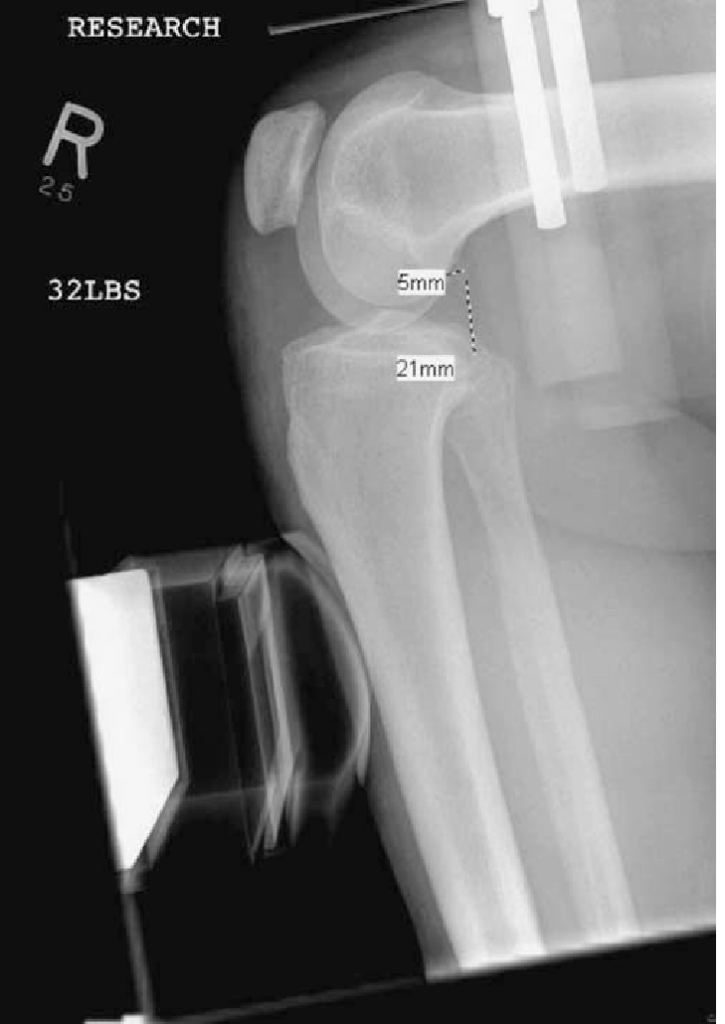

On the other hand, the Telos Stress Device maintains its value through stress radiographs, offering a clear, visual representation of knee structural integrity under load. However, concerns regarding radiation exposure and the manual variability in stress application highlight the device’s limitations.
3.2 Implications for Clinical Practice and Technological Advancement
The incorporation of dynamic arthrometers like the GNRB/Dyneelax into ACL management marks a pivotal shift. The Theo Cojean Study (2023) (7) underscores its utility in efficiently diagnosing partial ruptures, highlighting a pathway toward optimizing healthcare resources by reducing the reliance on MRI for initial assessments. This advancement not only accelerates the diagnostic process but also streamlines treatment planning, enabling quicker, more tailored interventions.
In postoperative contexts, as detailed by Nouveau et al. (2017) (8), Semay et al. (2016) (9), Pouderoux et al. (2019) (10), and Forelli (2023) (11), the role of arthrometers extends into monitoring graft healing and laxity. This capability offers clinicians a detailed map of the graft’s biomechanical changes, informing rehabilitation adjustments to safeguard against graft overloading. Such precision fosters a personalized rehabilitation approach, potentially lowering re-injury rates and supporting a more effective return to activity.
Furthermore, the GNRB/Dyneelax’s focus on rotational as well as translational knee stability fills a critical gap in understanding knee mechanics. Addressing both aspects ensures a comprehensive recovery strategy, particularly crucial for athletes aiming for a high-level return to sport.
Conclusion
The comparative analysis of the GNRB/Dyneelax and Telos Stress Device underscores the critical role of selecting the appropriate arthrometer for ACL injury assessment. The GNRB/Dyneelax, with its dynamic assessment capabilities, excels in diagnosing partial ACL ruptures and provides a comprehensive view of knee laxity by measuring anterior tibial translation along with internal and external rotation. This device’s efficiency not only streamlines the diagnostic process but also offers a viable, cost-effective alternative to MRI, potentially optimizing healthcare resources.
Conversely, the Telos Stress Device remains invaluable for its ability to visually document knee structural integrity under load through stress radiographs, despite concerns about radiation exposure and manual application variability.
Looking ahead, there is a compelling opportunity for future research to further enhance arthrometer technology and diagnostic accuracy. Innovations in this field promise to refine our understanding of knee biomechanics, improve the precision of ACL injury assessments, and tailor rehabilitation protocols more effectively. By continuing to advance arthrometer technology, clinicians can expect to achieve more nuanced diagnoses, optimize treatment plans, and ultimately, improve patient outcomes in ACL injury management.
Medical References (Link In DOI)
- Beldame, J., Mouchel, S., Bertiaux, S., & Adam, J.M. (2012). Anterior knee laxity measurement: Comparison of passive stress radiographs Telos® and ‘‘Lerat’’, and GNRB® arthrometer. Orthopaedics & Traumatology: Surgery & Research, 98, 744-750. DOI: 10.1016/j.otsr.2012.05.017
- Lefevre, N., Bohu, Y., Naouri, J.F., Klouche, S., & Herman, S. (2013). Validity of GNRB arthrometer compared to Telos in the assessment of partial anterior cruciate ligament tears. Knee Surgery, Sports Traumatology, Arthroscopy, 22, 285-290. DOI: 10.1007/s00167-013-2384-4
- Bouguennec, N., Odri, G.A., Graveleau, N., & Colombet, P. (2015). Comparative reproducibility of Telos™ and GNRB for instrumental measurement of anterior tibial translation in normal knees. Orthopaedics & Traumatology: Surgery & Research, 101, 301-305. DOI: 10.1016/j.otsr.2015.01.007
- Goncalves, D., Murgier, J., Beranger, J.S., Boisrenoult, P., Steltzlen, C., & Pujol, N. (2017). High Failure Rate of Anterior Cruciate Ligament Reconstruction with Bimeniscal Repair: A Case-Control Study. The Knee, 24, 856-862. DOI: 10.1016/j.otsr.2017.03.022
- Murgier, J., Beranger, J.S., Boisrenoult, P., Steltzlen, C., & Pujol, N. (2018). Prospective comparative study of knee laxity with four different methods in anterior cruciate ligament tears. International Orthopaedics, 42, 911-917. DOI: 10.1007/s00264-018-3791-4
- Ryu, S.M., Park, J.W., Na, J.B., Lim, H.T., & Bae, J.H. (2018). Diagnostic Tools for Acute Anterior Cruciate Ligament Injury: A Comparative Study. The Knee, 25, 414-420. DOI: 10.5792/ksrr.17.014
- Cojean T, Batailler C, Robert H, Cheze L. (2023). GNRB® laximeter with magnetic resonance imaging in clinical practice for complete and partial anterior cruciate ligament tears detection: A prospective diagnostic study with arthroscopic validation on 214 patients. Knee, 42, 373-381. DOI: 10.1016/j.knee.2023.03.017
- Nouveau, S., Robert, H., Viel, T. (2017). ACL Grafts Compliance During Time: Influence of Early Solicitations on the Final Stiffness of the Graft after Surgery. Journal of Orthopedic Research and Physiotherapy, 3(1), 035. DOI: 10.24966/ORP-2052/100035
- Semay, B., Rambaud, A., Philippot, R., Edouard, P. (2016). Evolution of the anteroposterior laxity by GnRB at 6 9 and 12 months post-surgical anterior cruciate ligament reconstruction. DOI: 10.1016/j.rehab.2016.07.045
- Pouderoux, T., Muller, B., Robert, H. (2019). Joint laxity and graft compliance increase during the first year following ACL reconstruction with short hamstring tendon grafts.. DOI: 10.1007/s00167-019-05711-z
- Forelli F, Le Coroller N, Gaspar M, et al. (2023). Ecological and Specific Evidence-Based Safe Return To Play After Anterior Cruciate Ligament Reconstruction In Soccer Players: A New International Paradigm. IJSPT. Published online April 2, 2023. DOI: 10.26603/001c.73031


